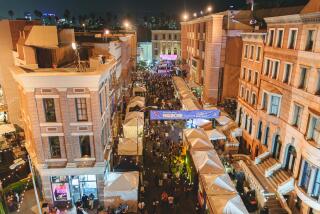TASTING THE PRODUCE REVOLUTION
OAKLAND — “Look at that color!” the woman exclaimed, peering down at a purple nugget the size of a golf ball. She picked it up and scratched at the skin with her fingernail; beneath the layer of dirt it was an even deeper purple, a sort of glowing amethyst color. “What do you suppose it tastes like?” she wondered. She hefted the little purple sphere and, when nobody was looking, surreptitiously took a bite. “Well?” asked her companion. A quizzical look crossed the woman’s face. “It tastes,” she said, “exactly like a potato.”
Purple potatoes were not the only oddities at the Tasting of Summer Produce, an annual Bay Area event. It all began four years ago when Sibella Kraus launched the Farm-Restaurant Project to forge a link between restaurateurs and growers. The 22-week Project culminated in the first tasting at Greens restaurant. Growers and chefs had such a good time meeting each other that they simply gathered up the produce at the end of the afternoon and created an impromptu feast.
From Greens the Tasting moved to the Mondavi winery, where it spilled out the door as restaurateurs knocked elbows tasting hundreds of different kinds of tomatoes, apples, melons and figs. “Have you tried the dry-farmed Early Girl tomatoes at Molino Creek?” one would whisper to another, and a herd of chefs would stampede over to that grower’s table. Clearly a bigger site was needed.
This year it got just that, as the Oakland Museum invited the tasting to sprawl across its many outdoor levels. Blessed with so much space, Kraus opened the tasting to the public for the first time, and 1,100 people came to see, taste and purchase state-of the art, hand-grown produce.
“I never knew there were so many different kinds of vegetables,” breathed one woman, cooing over a Chioggia beet, which looks ordinary enough on the outside but unfolds alternating circles of red and white when you cut it open. At the next taste was a gorgeous display of edible flowers, and, as the woman surveyed the calendulas and snapdragons and Johnny-jump-ups, she suddenly spotted something familiar. “I didn’t know you could eat impatiens, “ she sighed. “Really,” replied her companion, “I’ve been eating them for years.”
But even the most blase eaters found foods to amaze them. Purple okra. Tomatillos , the skin a faint aubergine color, the flesh so sweet you could eat them raw. Mushrooms in hues you hardly imagine--coral, bright canary, red. There were blood peaches, the color beneath the flesh like a miniature sunset, the flavor rich and particularly peachy. There were fabulous melons in about 100 varieties. There was a new kind of grape, called Bronx, which looks like a green grape, has no seeds and tastes exactly like a Concord. But to my mind the most exciting fruits were the dozens of different heirloom apples (they make the Delicious variety seem lackluster and dull), and dry-farmed tomatoes. These are never watered from the time the seedling plants are put into the ground; they are absolutely filled with flavor.
The Tasting of Summer Produce was once simply a way for small growers to meet the restaurateurs who used their lovingly raised fruits and vegetables. Now it is more than that; it has become one of the major forces behind the revolution that is bringing more and better produce into our lives. Once limited to restaurants, the produce revolution is now touching us all. Four years ago arugula and radicchio seemed exotic; four years from now we may barely give purple potatoes a second glance.
More to Read
Eat your way across L.A.
Get our weekly Tasting Notes newsletter for reviews, news and more.
You may occasionally receive promotional content from the Los Angeles Times.









